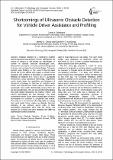| dc.contributor.author | J.I. Obuhuma, H.O Okoyo, S.O. McOyowo | |
| dc.date.accessioned | 2020-11-24T11:05:04Z | |
| dc.date.available | 2020-11-24T11:05:04Z | |
| dc.date.issued | 2019 | |
| dc.identifier.uri | https://repository.maseno.ac.ke/handle/123456789/2953 | |
| dc.description.abstract | Obstacle detection is a challenging problem
that has attracted much attention recently, especially in the
context of research in self-driving car technologies. A
number of obstacle detection technologies exist.
Ultrasound is among the commonly used technologies due
to its low cost compared to other technologies. This paper
presents some findings on the research that has been
carried out by the authors with regard to vehicle driver
assistance and profiling. It discusses an experiment for
detection of obstacles in a vehicle driver’s operational
environment using ultrasound technology. Experiment
results clearly depict the capabilities and limitations of
ultrasound technology in detection of obstacles under
motion and obstacles with varied surfaces. Ultrasound’s
wavelength, beam width, directionality among others are
put into consideration. Pros and cons of other technologies
that could replace ultrasound, for instance RADAR and
LIDAR technologies are also discussed. The study
recommends sensor fusion where several types of sensor
technologies are combined to complement one another.
The study was a technical test of configurable technology
that could guide future studies on obstacle detection
intending to use infrared, sound, radio or laser
technologies particularly when both the sensor and
obstacle are in motion and when obstacles have differing
unpredictable surface properties. | en_US |
| dc.publisher | Int. J. Inf. Technol. Comput. Sci | en_US |
| dc.subject | Obstacle Detection, Driver Profiling, Ultrasound, Ultrasonic Sensors, Bayesian Network, 2TBN, Sensor Fusion, Driver Assistance | en_US |
| dc.title | Shortcomings of Ultrasonic Obstacle Detection for Vehicle Driver Assistance and Profiling | en_US |
| dc.type | Article | en_US |

